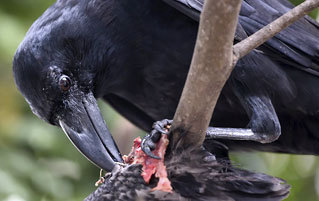5 Insane Supervillain Schemes by Real Governments

No matter how many deranged, megalomaniacal psychopaths there are in our governing bodies, political shenanigans are usually less about flamethrower robots and more about balding men in suits lying about fiscal policy. But occasionally the government will put forth a plot so insane that even the most hardened Bond villain would ask them if everything is all right at home and tell them to tone it down a little.
The CIA's Legion of Spy Ravens

Ominous entities from Odin to Saruman know it: No matter how powerful you are or how sizable your operation is, you ain't got no game until you have your own posse of ravens to spy on your adversaries. So it's no surprise that during the late 1960s the CIA stumbled across some old Viking legends and thought, "Hey, that's what we've been missing all these years -- theatrics!"

This was the same reason they pumped millions into improved banana phone technology.
The agency turned to Bob Bailey, a pioneering animal behaviorist who had already overseen a number of hilarious projects, such as the Acoustic Kitty (a cat with a listening device) and the World War II-era pigeon missile (an actual missile full of actual pigeons that guided it by pecking a map). At this point, it's probably good to remember that there was quite a lot of LSD floating around Langley at the time.
Bailey planned to train his birds to carry listening devices that they would deposit on window ledges and rooftops. He also designed a tiny camera that the raven would activate by pushing it against a window. Because the world is apparently a cartoon, Bailey's plan was a roaring success, and the CIA happily shelled out the cash to build spy-raven training facilities. The next steps: motorcycle-riding mice and martial arts-practicing turtles.

"If we can't train them, we can feed them to the ravens."
Sadly, the spy-raven program was terminated in the 1970s. However, Bailey strongly insinuates that the ravens were successfully used in the field a number of times. He even jokingly hints that there might be CIA-trained "rogue" raven agents out there today. And that goddamn well better be the plot of the next Bourne movie.
Japan's Army of Plague-Fleas
It was the summer of 1945, and things weren't going well for the Japanese. Their only remaining chance of victory was to deliver a truly devastating knockout blow to the Allies. Such an important last-resort move could not be trusted to just anyone, so naturally the Japanese military turned to a bona fide mad scientist.
While we're sure he wouldn't have described himself as "mad" (so few evil scientists show that level of self-awareness), the evidence disagrees: Shiro Ishii served as the head of Unit 731, a covert biological warfare research team, and there really is no positive way to spin that kind of thing, is there? There was no "covert biological warfare research team" whose primary goal was to produce the fluffiest bunnies the world had ever seen so all the troops would stop fighting and start snuggling.

"We tried that with the Lennie Project. It failed."
No, mysterious biowarfare units generally pull crazy supervillain-level stunts like breeding millions of fleas infected with the plague to release them on their unsuspecting enemies. Which is exactly what Ishii planned on doing, incidentally.
One of Japan's fancy new aircraft-carrying submarines was supposed to surface off the coast of San Diego one night and launch three planes. The aircraft would release special ceramic bombs that shattered as they fell, unleashing hordes of Ishii's plague-minions over the city and devastating the area. Out of other, saner options, Japanese higher-ups gave their blessings and dubbed it Operation Cherry Blossoms at Night. Hey, in wartime, you have to create beauty whenever you can -- if only to balance out the horror (of plague-infected flea bombs, for example).

Operation Itchy Dog Ass didn't inspire as much pride.
This was not some far-fetched scheme that didn't make it past the drawing board: They actually built the bombs and set up the aircraft, but at the last second they called off the attack. Japan was worried that the U.S. had their own superweapons in the works, and they didn't want to start a war of escalation. They shelved their own sinister megaweapons in the hopes that the U.S. would do the same. It didn't exactly shake out that way.
It's not often that the guys funding the army of plague fleas come out looking like the sane ones, is it?
The U.S. Tries to Win Vietnam With Weather Manipulation

Most people, thanks largely to their crazy uncle's rambling Facebook posts, are familiar with chemtrails, the chemical-laced aircraft contrails that the secret government uses to cause cancer, obesity, and Muslims. Cloud seeding is the same deal, but the other way around: Although the technique does involve introducing chemicals into the sky, it's meant to manipulate the weather, instead of autism or impotence or whatever the chemtrail folks are on about these days. Also unlike chemtrails, cloud seeding is real: The American military and CIA first started using the technique in Vietnam in 1963, for the hilariously petty purpose of trying to summon rain on Buddhist protest marches.

Try immolating yourselves now, monks!
But they didn't stop with literally raining on some parades: The sheer scale of the cloud-seeding operation against the Ho Chi Minh Trail was above and beyond any weather control attempt the U.S. had ever made before. Codenamed Operation Popeye, the plan was to fly modified cargo planes along the trail, releasing silver and lead iodine flares into the sky over Laos, Cambodia, and North Vietnam. This was supposed to heavily increase rainfall and lengthen the monsoon period, which would have messed up communications and supply runs for the Viet Cong.

And ruined their already limited cookout days.
Between the operation's start in 1967 and its termination in 1972, cargo planes flew a monumental 2,606 missions, dropping over 47,000 cloud-seeding charges all over the trail, until the whole area was eventually reclaimed by the angry sea.
Or ... nothing. Nothing actually happened. At least not in the intended region, at the intended time.
That's something they never tell you about playing God: Even if you get past the moral quandaries, it's just really, really hard to pull off.
Britain Wants to Steal ... the Nile?

In 1956, the British Empire was falling apart, but they weren't about to give up the Suez Canal just because Egypt had decided to run off with that wanton hussy, Independent Rule. Britain was used to exercising unofficial control over the strategically vital channel, but under the leadership of Gamal Abdel Nasser, Egypt had forced Britain to withdraw its troops from the country and nationalized Suez.

He took his frustration at not being able to grow a decent mustache out on an entire empire.
Britain needed to get the canal back, but how? The British Colonial Office thought they had the answer: crazy an-eye-for-an-eye geopolitical justice. If Egypt took a valuable body of water from them, well, they'd take one right back. That's right: They hatched a plot to steal the Nile River. We'll give you a dollar if you managed to resist reading that last sentence in your best Nicolas Cage voice.
The plot isn't as outlandish as it sounds: Britain still controlled Uganda, where the source(ish) of the Nile lay. And it just so happened that they had been building a dam there already. Why, it would be just shocking if somebody down at the dam happened to press the wrong button. The Nile might find itself reduced by seven-eighths by the time it reached Egyptian farmland.

And if that failed, the Angel of Death would simply slay every Egyptian firstborn.
The Brits took the plan all the way to the prime minister's office, where it was finally rejected because it would also deprive two other countries of most of their water, and because nobody wants "stealing a river" on their criminal record, save for Captain Planet villains. But it was a serious proposal: The colonial secretary gave a speech detailing the backhanded threat. Shockingly, Egypt remained unfazed, so Britain gave up the tactic. (To be fair, maybe the Egyptians just thought "We will shut off the Nile" had to be some sort of wacky mistranslation.)
The Nazi Plan to Devastate New York With Radioactive Sand from Rocket-Fueled Space Planes
Basic geography was a problem for the Nazis (also problems for the Nazis: general evil and public relations). They simply did not have a bomber that could carry enough fuel to make it from Germany to New York, and a quick stop in London to refuel before crossing the Atlantic was not an option because those silly Brits just couldn't take a prank-blitz or 10.

They tried the Azores, but the Brits had called dibs on those already.
A Luftwaffe scientist named Eugen Sanger came up with a plan for a manned jet plane that would be shot into space, where it would conserve fuel by skipping across the atmosphere "like a stone bouncing over a pond." The most ridiculous thing about this particular Wile E. Coyote-sounding Nazi plot was that it actually might have worked.
The plane was to be launched from a huge rocket-powered sled propelled along train tracks at 1,200 miles per hour. Just before the tracks ran out, the plane would take off and be instantly flung 90 miles above the Earth, using its sheer speed to skip across the denser parts of the stratosphere. Once the jet reached New York, it would detonate a bomb packed with radioactive sand, casting a devastating radiation cloud over the city.

Then the Yanks would fall, and the crab people would rise. Nazi crab people.
Luckily for New York and other American cities, we had Captain America to bash those Ratzis back to the Stone Age with his trusty shie- oh wait, no. There were some calculation errors, and the plane was just too difficult and costly to build. That's the true superhero of this story: budgetary concerns.
When he isn't trying to figure out why the snowplow always piles snow into his driveway, Evan can be found on Facebook. He is part of the fantastic new podcast featuring Cracked Workshop moderators.
Always on the go but can't get enough of Cracked? We have an Android app and iOS reader for you to pick from so you never miss another article.
Related Reading: Some American presidents had origins worthy of a supervillain. Calvin Coolidge was basically a psycho. Also a supervillain? Leonardo Da Vinci. He had his own damn robot army. Ready for more of the craziest schemes ever hatched? Click here.


